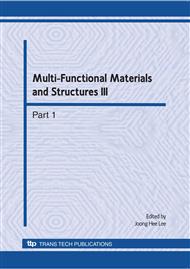p.599
p.603
p.607
p.611
p.615
p.619
p.623
p.627
p.631
Aggregation Characteristics of Cu and Ag Nanoparticles in Presence of Starch as the Polymer Stabilizer
Abstract:
This presentation deals with the aggregation characteristics of Cu and Ag nanoparticles in presence of starch as the polymer stabilizer. Uncontrolled aggregation of the destabilized nanoparticles offers problem for applications based on surface plasmon activity. Polymer or small molecule surfactants are used to control nature of aggregation of nanoparticles produced by chemical reduction synthesis routes. Different growth models such as diffusion limited cluster aggregation (DLCA), reaction limited cluster aggregation (RLCA) proposed to explain the formation of fractal colloidal aggregates do not account for aggregate formation in presence of polymer or small molecule surfactants. We shall be discussing the role of starch on the aggregation characteristics of copper and silver nanoparticles formed by chemical reduction in aqueous conditions. The effect of NaOH concentration and consequently the pH on such aggregation kinetics during such synthesis is delineated. We use small angle x-ray scattering (SAXS) to quantitatively understand different aspects of aggregation behavior.
Info:
Periodical:
Pages:
615-618
Citation:
Online since:
August 2010
Authors:
Keywords:
Price:
Сopyright:
© 2010 Trans Tech Publications Ltd. All Rights Reserved
Share:
Citation:


